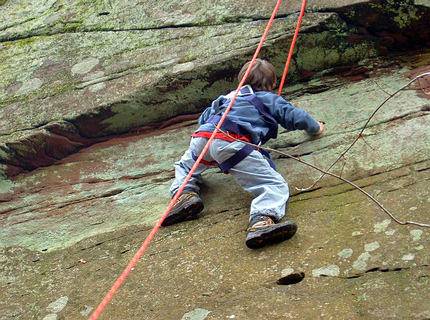source: www.youthwork-practice.com | 2000 Games, Devotions, Themes, Ideas and more for Youth Work
only for private using
Climbing

Climbing with youth ©: Alexander Raths - Fotolia
This is about overcoming one's own limits and getting the body used to movements, which seem to be lost in the modern children and adolescents. These are just some of the reasons why climbing is such an important element in the experiential learning environment. Let me tell you why: all muscles from head to toe are trained, and while participants gradually hike to lofty heights, they also overcome their limits. Even a small amount of just a few meters, when viewed from above, will give most participants a queasy feeling if not triggering downright feelings of fear.
Taking responsibility for one another
One underlying principle while climbing is: No one goes alone, and is always connected to at least one partner. In an emergency, these precautions, can save lives in a rope team. In terms of experiential learning this measure also serves another objective: The participants will learn to take responsibility for themselves and others. In the worst case scenario, a single misstep could mean that you and the partner you are roped together could both plummet downwards.

exercise rock climbing | ©: www.youthwork-practice.com
However, in climbing schools all participants are additionally protected by safety ropes. Nonetheless, those safety measures do not take away the illusion that all participants are climbing solely and, therefore, have to rely on their physical abilities and those of their partner. This not only strengthens the self-confidence of the individual but also the team spirit of all party members.
Climbing Park or Hall?
If possible, the joint climbing adventure should take place in a climbing park rather than in a hall. Usually, in a climbing park the group can climb together without being disturbed by others. Also climbing tours with a different level of difficulty can be put together. The group can manage multiple climbing adventures each day and with each new attempt they can increase the challenge.

Climbing in a hall | ©: S.-Hofschlaeger - pixelio.de

Climbing at via ferrata | ©: Andrea Huntemann - Fotolia
A positive side effect is that the participants experience nature much more intense than in an anonymous climbing gym. Nature can be perfectly integrated into this experiential learning adventure. For example, after they climbing experience the group as a whole could go for a picnic. This gives the participants the opportunity to talk about their impressions of the event. This is also a good moment where possible conflicts can be solved. It’s possible that while climbing one of the participants made a mistake, which left the rest of the group reeling. If this issue is not addressed and resolved, there is the potential for an underlying conflict to fester.
Finally, admitting of errors or misunderstandings is also part of building trust, which is an important element in this adventure-based event. For at least basic trust is mandatory when a climber takes his rope team into the unknown world of the mountains.
More informations and ideas concerning outdoor education
- Article: Experience pedagogic | Outdoor education
- Article: Cooperative Adventure Games
- Article: Converting types of games and activities
- Forest games
- Trips with the Sailboat
- Snowshoeing
- Rafting
- Orientation Hike
- Cross-country skiing/ski touring
- via ferrata
- Climbing
- Canoeing
- Kayaking
- En route with a float
- Cycling
- Hiking and mountain tours
- Cave tours
- Rope events
- Canyoneering
- Tree climbing
- Bivvy
[ © www.youthwork-practice.com | 2000 Games and Ideas for Youth Work ]






